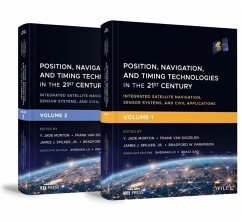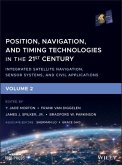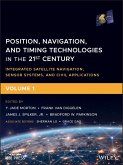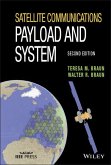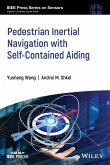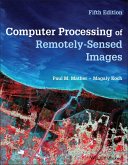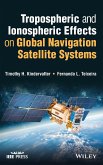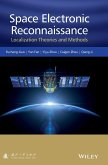Y. Jade Morton, PhD is a Professor at Ann and H. J. Smead Aerospace Engineering Sciences Department, University of Colorado at Boulder. Her research interests lie at the intersection of satellite navigation and remote sensing of the space environment, atmosphere, and Earth surface. She has led numerous research projects sponsored by AFOSR, AFRL, DARPA, NASA, NSF, ONR, and private industries. Dr. Morton is the President of the Institute of Navigation (ION), a fellow of IEEE, ION, and the Royal Institute of Navigation (RIN, UK). Frank Van Diggelen, PhD is a Principal Engineer at Google, where he leads the Android Core-Location Team. He also teaches at Stanford University. He is the inventor of coarse-time GNSS navigation, co-inventor of Long Term Orbits for A-GNSS, and the author of A-GPS the first textbook on Assisted GNSS. He is Executive Vice President of the Institute of Navigation (ION) and a Fellow of the ION and the Royal Institute of Navigation (UK). James J. Spilker, Jr., PhD was a Consulting Professor in the Aeronautics and Astronautics Department at Stanford University. Dr. Spilker was an elected member of the National Academy of Engineering, a Life Fellow of the IEEE, and a Fellow of the Institute of Navigation (ION). As one of the originators of GPS, James Spilker shared the Goddard Memorial Trophy and the Queen Elizabeth Prize for Engineering. Bradford W. Parkinson, PhD is an Edward C. Wells Professor of Aeronautics and Astronautics Emeritus at Stanford University. Dr. Parkinson was the Chief Architect for GPS, led the original advocacy and development for the system, and served as the first Director of the GPS Joint Program Office. He has been the CEO of two companies and serves on many boards. Among his many awards are the IEEE Medal of Honor, the Draper Prize of the National Academy of Engineering, and the Queen Elizabeth Prize for Engineering.
Volume 1 Satellite Navigation Systems, Technologies, and Applications
Part A: Satellite Navigation Systems
1. Introduction, Early History, and Assuring PNT (PTA)
Bradford W. Parkinson, Stanford University, US
Y. T. Jade Morton, University of Colorado Boulder, US
Frank van Diggelen, Google, US
James J. Spilker Jr., Stanford University, US
2. Fundamentals of Satellite-Based Navigation and Timing
John W. Betz, the Mitre Corporation, US
3. The Navstar Global Positioning System
John W. Betz, the Mitre Corporation, US
4. GLONASS
Sergey Karutin, PNT Center, Russia
N. Testoedov, PNT Center, Russia
A. Tyulin, PNT Center, Russia
Alexei Bolkunov, PNT Center, Russia
5. Galileo
José Ángel Ávila Rodríguez, European Space Agency, the Netherlands
Jörg Hahn, European Space Agency, the Netherlands
Miguel Manteiga Bautista, European Space Agency, the Netherlands
Eric Châtre, European Commission, Belgium
6. Beidou Navigation Satellite System
Mingquan Lu, Tsinghua University, China
Zheng Yao, Tsinghua University, China
7. The India Regional Navigation Satellite System
Vyasaraj Rao, Accord Software and Systems, India
8. Quasi-Zenith Satellite System
Satoshi Kogure, National Space Policy Secretariat, Japan
Yasuhiko Kawazu, National Space Policy Secretariat, Japan
Takeyasu Sakai, National Institute of Maritime, Port, and Aviation Technology, Japan
9. GNSS Interoperability: Purpose, Process, Progress, and Myths
Thomas A. Stansell, Jr., Stansell Consulting, US
10. Signal Quality Monitoring
Frank van Graas, Ohio University, US
Sabrina Ugazio, Ohio University, US
11. GNSS Orbit Determination and Time Synchronization
Oliver Montenbruck, German Aerospace Center, Germany
Peter Steigenberger, German Aerospace Center, Germany
12. Ground-Based Augmentation Systems for Aviation Applications
Boris Pervan, Illinois Institute of Technology, US
13. Satellite-Based Augmentation Systems
Todd Walter, Stanford University, US
Part B: Satellite Navigation Technologies
14. GNSS Receivers: An Overview
Sanjeev Gunawardena, Air Force Institute of Technology, US
Y. T. Jade Morton, University of Colorado Boulder, US
15. GNSS Receiver Signal Tracking
Y. T. Jade Morton, University of Colorado Boulder, US
Rong Yang, Shanghai Jiaotong University, China
Brian Breitsch, University of Colorado Boulder, US
16. Vector Processing
Matthew V. Lashley, Auburn University, US
Scott Martin, Georgia Tech Research Institute, US
James Sennott, Tracking and Imaging Systems, US
17. Assisted GNSS
Frank van Diggelen, Google, US
18. High Sensitivity GNSS
Frank van Diggelen, Google, US
19. Relative Positioning and RTK
Sunil Bisnath, York University, Canada
20. GNSS Precise Point Positioning
Peter Teunissen, Curtin University, Australia
21. Direction Position Estimation
Pau Closas, Northeastern University, US
Grace Gao, Stanford University, US
22. Robust Positioning in the Presence of Multipath and NLOS GNSS Signals
Gary A. McGraw, Rockwell Collins, US
Paul D. Groves, University College London, UK
Benjamin W. Ashman, National Aeronautics and Space Administration, US
23. GNSS Integrity
Sam Pullen, Stanford University, US
Mathieu Joerger, Virginia Tech, US
24. Interference, Security, and Proof of Location
Logan Scott, Logan Scott Consulting, US
25. Civilian GNSS Spoofing, Detection, and Recovery
Mark Psiaki, Virginia Tech, US
Todd Humphreys, University of Texas Austin, US
26. GNSS Antenna and Antenna Array Signal Processing
Andrew O'Brien, the Ohio State University, US
Chi-Chih Chen, the Ohio Stat

